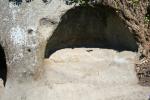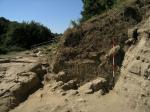Summary (English)
This was the 41st excavation campaign on the Final Bronze Age settlement of Sorgenti della Nova (Farnese, VT). The excavations were carried out by the Centre for Prehistory and Archaeological Studies ONLUS, Milan in collaboration with the Archaeological Superintendency for Lazio and South Etruria.
A few days were spent clearing the areas to be excavated and setting up visitors routes within the site. The research then concentrated on two sectors: the first already the subject of excavations, sector Vb, the second a new area, sector XIII.Sector Vb, situated at the base of the southern slope of the cliff was reopened in 2007 in order to continue the investigation of one of the settlement’s most interesting structures, only partially explored due to its substantial size, in the 1990s. This was a long “ditch” house, c. 4 m wide and 2 m deep, uncovered for over 30 m, but certainly extending further beyond the eastern edge of the sector. Only a few metres of its length were fully explored, confirming its residential function and showing that the ditch was deliberately filled already in the Final Bronze Age.
Over recent years, work has concentrated on the easternmost end of the sector, beyond the steps leading to the upper terraces of the rock outcrop, where the excavations were previously extended to investigate the hypothetical continuation of the ditch structure (sector Vb, east area). Here, previous campaigns uncovered a section of artificial terrace with at least two occupation phases, both within the Final Bronze Age. At the eastern end of the extension, the rock parapet above the terrace was reached and the layers of medieval and post-medieval collapse removed. Sporadic traces of Etruscan occupation were documented. In addition, traces of a sunken, rock-cut structure were found, filled by collapsed boulders, which seemed to gradually widen to the east, suggesting the presence at this point of a possible entrance.
This year the collapse identified during the previous season was removed in an attempt to understand whether, as in the section explored in the 90s, there were was any evidence for it being an artificial fill of the structure, or was the result of the natural erosion of the rocky slope above it. The excavation showed that the apparently uniform mass was in fact formed by distinct episodes and that numerous elements of a different nature (yellow tufa) were present between the boulders that were analogous to the rock in which the structure was cut. The presence of different elements suggests the fill was only partially natural. All of the archaeological materials from the layers were of proto-historic date.
The new sector XIII opens on the south side of the rock, on the easternmost part, downhill with respect to the fully-excavated sector XII. Here, there is a rather narrow but long terrace with three caves facing onto it that are still accessible, with clear traces of proto-historic working and adaptation in the medieval period. This feature was identified during a survey and was also visible in old excavation photographs. Excavation began in the easternmost cave, which was the largest and showed the least evidence of later enlargements and restructuring. This season, work was limited to the removal of the latest abandonment levels, revealing a beaten surface and a stone structure for draining water that dripped from the ceiling during heavy rain. Two niches were identified in the internal wall that showed traces of reddening, indicating fires had been lit inside them. Excavations in front of the cave, east of the entrance, reached the bedrock that was seen to have been smoothed by the elements. On the rock face on the same side of the entrance, there was a large niche showing alteration caused by exposure to fire, perhaps the remains of a rock-cut oven, later altered for other purposes.
- Nuccia Negroni Catacchio - già Università degli studi di Milano, Politecnico di Milano, Centro Studi di Preistoria e Archeologia, Milano
Director
Team
- Christian Metta - Centro Studi Preistoria e Archeologia
- Giulia Pasquini - Centro Studi Preistoria e Archeologia
- Marco Romeo Pitone- Centro Studi di Preistoria e Archeologia
- Veronica Gallo- Centro Studi di Preistoria e Archeologia
- Massimo Cardosa - Accademia di Belle Arti di Brera e Centro Studi di Preistoria e Archeologia
Research Body
- Centro Studi di Preistoria e Archeologia, Milano onlus
- Comune di Farnese
- Regione Lazio
- Università degli Studi di Milano
Funding Body
- Fondazione Carivit






![Download [PDF]](/excavation/skins/fasti/images/results/download_sml.png)

